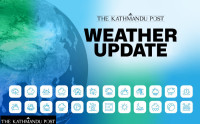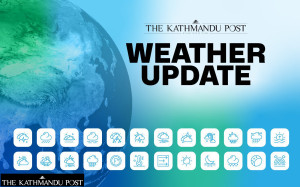Weather
Experts call for preparedness to deal with monsoon-related disasters
In addition to flooding and landslides, the country witnesses several other monsoon-related incidents that receive much less attention.
Arjun Poudel
Geologists and seismologists have identified cracks and fissures in over 200 places in Jajarkot and West Rukum of Karnali Province—the two districts most affected by a magnitude 6.4 earthquake on November 3 last year.
Surface ruptures in some places of the two districts are so deep and wide that experts deployed in the aftermath of the disaster deemed them unfit for residence.
At least 157 people died, hundreds were injured and thousands displaced in the November 3 earthquake.
“Residents of those areas are among the 1.81 million vulnerable population of 412,000 households. They could be affected in some ways in the upcoming monsoon,” says the risk and damage assessment prepared by the National Disaster Risk Reduction and Management Authority (NDRRMA) for the upcoming monsoon season. “As many as 83,000 households will be directly affected, and 18,000 families need to be rescued in monsoon-related disasters.”
However, the vulnerable populations have still been residing in places designated by the expert groups as unfit for living. There are hundreds of such places across the country where thousands of people are living in disaster-prone areas, government officials concede. What concerns experts is apart from flooding, landslides and innundations, the country witnessed several other monsoon-related incidents to which adequate attention has not been paid.
“Neither the vulnerable populations will relocate to safe places nor the authorities concerned have any immediate plans to relocate them,” an official at the authority said, asking not to be named as he is not authorised to speak to the media. The country’s limited resources cannot pay for their relocation.
Experts from the authority say that most districts in the Tarai could be affected by flooding this rainy season. The vulnerable places include Rapti-Sonari Rural Municipality of Banke, Bardiya, Tikapur of Kailali, Triveni-Susta Rural Municipality of Nawalparasi West, Kalahari Rural Municipality of Morang, and several places of Rautahat.
Several places in West Rukum, Jajarkot, Helambu, and Melamchi of Sindhupalchok, Sangurigadhi Rural Municipality of Dhankuta, Maiwakhola Rural Municipality of Taplejung, and Chumnubri of Gorkha are designated as most vulnerable to landslides during the monsoon, due to begin this week. The Department of Hydrology and Meteorology predicts above-average rainfall this year, with the added risk of flooding and landslides.
“We are not doing anything for the prevention of disasters or the relocation of the most vulnerable populations to safety,” said Mahendra Shrestha, former chief specialist at the Ministry of Health and Population. “Concerned authorities have made a preparedness plan, but there is nothing about prevention.”
Monsoon in Nepal is a season of epidemics, with thousands of people across the country getting infected with water-borne and vector-borne diseases. Snakebite incidents and resulting deaths are also common during the season but the phenomenon, which experts dub “a lurking invisible crisis”, remains grossly neglected. Scores die, and thousands of people get infected with the dengue virus every monsoon.
Most sources of drinking water generally become contaminated during the rainy season. People residing in disaster-hit areas, and those displaced by natural disasters are highly vulnerable to infections with waterborne and vector-borne diseases.
Officials at the National Disaster Risk Reduction and Management Authority said they have started preparations accordingly to deal with possible incidents of disasters in the coming days.
The authority has prepared the ‘Monsoon Preparedness and Response Plan-2081” to deal with disaster incidents.
Agencies under the ministries including the Ministry of Home Affairs, Ministry of Health and Population, Ministry of Urban Development, and Ministry of Water Supply have a crucial role in disaster response. UN agencies also play a major role by providing aid, according to Dijan Bhattarai, spokesperson for the authority. “Logistics and relief materials have already been stocked up in the warehouses of all seven provinces and 12 logistics hubs.”
Officials say each and every agency, including the Army, Police, Armed Police Force, non-governmental organisations, and agencies under ministries, have their own responsibilities and they should act proactively during disasters.
Experts say that Nepali authorities have not learned anything from the experiences, mistakes, and blunders they made in the past and do not try to avoid the same mistakes again and again.
“Authorities make the plan to count the victim’s number, fly choppers to ferry leaders and ministers to disaster-hit areas and distribute relief materials but do not make any plan for preventing disasters,” said Shrestha, the former chief specialist.
“More people get affected in the aftermath of disasters than in the disasters. The risk of disease outbreaks increased in the aftermath of disasters, and problems of malnutrition, and mental health, among others, increased.”
In the past few years, the country has been receiving more rainfall in short durations—an abnormal phenomenon that is slowly becoming a new normal. Experts say changes in rainfall patterns, which have become severe and erratic in the past few years as an impact of climate change, have contributed to extreme weather events like floods and landslides annually.




 19.12°C Kathmandu
19.12°C Kathmandu






